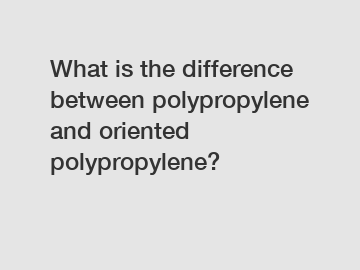What is the difference between polypropylene and oriented polypropylene?
Polypropylene and oriented polypropylene are both types of plastic materials commonly used in various industries. However, they have distinct characteristics and applications that set them apart. .
Polypropylene (PP) is a thermoplastic polymer that is widely used for its excellent chemical resistance, high melting point, and good mechanical properties. It is a versatile material that can be easily processed into different forms, such as films, fibers, and molded parts. PP has a relatively low density, making it a lightweight option for many applications. Additionally, it is highly resistant to moisture, oils, and solvents, making it suitable for packaging, textiles, and automotive components.
On the other hand, oriented polypropylene (OPP) is a specific type of polypropylene that has been specially processed to enhance its mechanical properties. The orienting process involves stretching the polypropylene film in one or two directions, which aligns the polymer chains and improves strength, clarity, and dimensional stability. OPP films exhibit higher stiffness and tensile strength compared to regular PP films, making them ideal for applications where durability and rigidity are essential, such as packaging for food, cigarettes, and pharmaceuticals.

The difference between polypropylene and oriented polypropylene lies primarily in their physical properties and processing methods. Regular polypropylene is a versatile material, offering excellent resistance to chemicals and a wide range of applications. It can be molded into various forms, but it may lack the added strength and dimension stability of oriented polypropylene. .
The orienting process gives OPP films a biaxial or uniaxial molecular structure, resulting in improved tensile strength, tear resistance, and transparency. This makes OPP films highly suitable for applications that require high-quality packaging, including clear bags, labels, and wrapping. Additionally, the enhanced mechanical properties of OPP make it a preferred choice for the production of tapes and synthetic papers.
The significance of understanding the difference between polypropylene and oriented polypropylene lies in the selection of the most suitable material for specific applications. Regular polypropylene is more cost-effective and suitable for general-purpose use, while oriented polypropylene provides enhanced performance in terms of strength and clarity. By choosing the appropriate material, manufacturers can optimize their production processes and ensure the quality and functionality of their products.
In conclusion, polypropylene and oriented polypropylene are both valuable plastic materials, each with its own unique characteristics and applications. Polypropylene is a versatile material with excellent chemical resistance, while oriented polypropylene undergoes an additional processing step to enhance its mechanical properties and clarity. Understanding the difference enables manufacturers to select the most suitable material for their specific needs, ensuring optimal performance, durability, and cost-effectiveness.
If you are looking for more details, kindly visit bopp film, pet metallised film, biaxially oriented polypropylene (bopp).

Comments